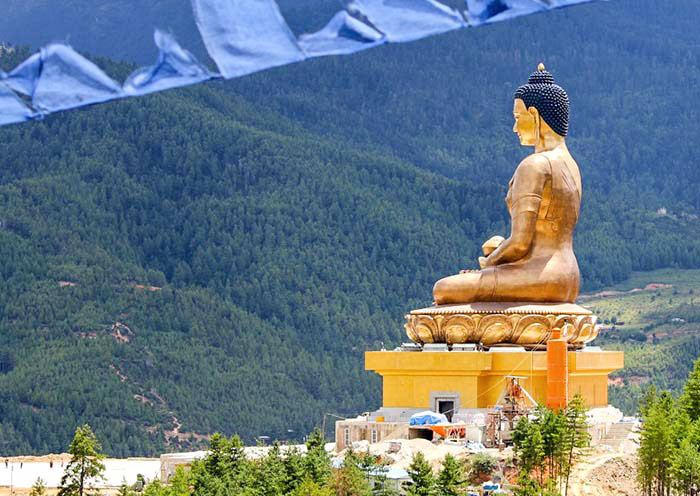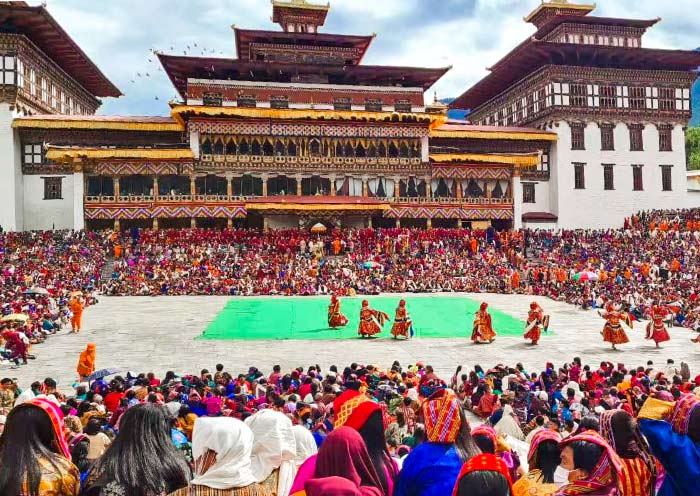



The weather in Bhutan is known for its clear skies, intense sunlight, and significant temperature swings from day to night. Its distinct seasons bring a unique rhythm to exploring this mountainous kingdom, with average temperatures ranging from 5 °C to 20 °C. Bhutan enjoys plenty of sunshine year-round, often surpassing 2500 hours, making for a comfortable travel experience.
Every season in Bhutan has its charm. Spring brings mild weather and bursts of blooming flowers across the country. Summer, while wetter, turns the landscape into a lush paradise, with terraced rice fields and forests in deep green hues. Autumn arguably presents the most stunning scenery, with fresh air and unmatched views of the majestic Himalayas, perfect for hiking and outdoor adventures. Winter, though cooler, tends to be sunny and tranquil, offering a chance to witness Bhutan's enchanting cultural festivals.
The best times to visit Bhutan are from March to May and September to November when the weather is most favorable, and the views are spectacular. These months correspond with the peak tourist season. Outside these periods, from December to February, tourism dips slightly due to the colder climate and occasional snow in higher elevations.
This Bhutan Weather Guide offers a detailed monthly breakdown, travel tips for top destinations, and answers to common questions about Bhutan's climate. With this information, you can plan your trip confidently, ready to enjoy Bhutan's natural beauty and cultural wealth, no matter the season.

"Excellent Tour, best experience"
"A unique experience despite a difficult context thanks
to an experience team of organisers"
Dive into the Bhutan weather chart for an annual overview of average temperatures and rainfall. This valuable resource empowers you to meticulously plan your journey and foresee the climatic conditions you'll encounter. Embrace the distinct allure of each season in Bhutan, from the cozy winters to the comfortable summers.


The best time to visit Bhutan is from March to May and September to November. Discover more about the best time for travel in Bhutan, the array of activities you can participate in, and obtain comprehensive travel guides to turn your Bhutanese adventure into a memorable experience!




Bhutan follows a “High Value, Low Impact” tourism policy but doesn't limit the number of tourists.
Bhutan can be reached by air through Paro International Airport, which is Bhutan's only international airport. Flights to Bhutan are available from major cities such as Delhi, Kolkata, Bagdogra, Gaya, Guwahati in India, Dhaka in Bangladesh, Bangkok in Thailand, Kathmandu in Nepal, and Changi in Singapore.
| No. | Place | Description |
|---|---|---|
| 1 | Tiger’s Nest Monastery (Paro Taktsang) | A famed cliffside monastery offering spiritual experiences and breathtaking views. |
| 2 | Punakha Dzong | Known for its stunning architecture and historical importance, it's located at the confluence of two rivers. |
| 3 | Thimphu | The capital city blending traditional and modern elements, with attractions like Tashichho Dzong and the Buddha Dordenma statue. |
| 4 | Phobjikha Valley | A scenic glacial valley, famous as the winter home of black-necked cranes and for its natural beauty. |
| 5 | Bumthang Valley | The spiritual heartland of Bhutan, home to some of the oldest temples and monasteries. |
| 6 | Rinpung Dzong | An important religious and administrative center in Paro, showcasing Bhutanese architecture. |
| 7 | Chele La Pass | One of Bhutan's highest motorable passes, offering panoramic views of mountains and valleys. |
| 8 | Haa Valley | A less-traveled valley noted for its pristine nature and insight into the traditional Bhutanese lifestyle. |
| 9 | Trongsa Dzong | A centrally located dzong with significant historical value and spectacular views. |
| 10 | Dochula Pass | Known for its 108 memorial chortens, stunning Himalayan views, and the Druk Wangyal Lhakhang temple. |
Find more information View 10 Best Places to Visit in Bhutan>>
Bhutan is renowned for its unique approach to national happiness, stunning Himalayan landscapes, rich Buddhist culture, and well-preserved environmental beauty. It's famous for the iconic Tiger's Nest Monastery, traditional architecture like dzongs, vibrant festivals like Tshechus, and its philosophy of Gross National Happiness. Bhutan is also recognized for its commitment to environmental conservation, being one of the few carbon-negative countries in the world.
It typically needs 6 to 10 days. For a 6-day tour, it is highly recommended to visit Paro - Thimphu - Punakha, and return to Paro. Begin in Western Bhutan with around 2 days in Paro, followed by Thimphu (1-2 days) and Punakha (1-2 days). Or, extending your trip by 1-2 days will allow you to explore the less-visited Haa or Phobjikha valleys. To delve deeper into Bhutan's cultural heritage, head to central Bhutan for 1-2 days to visit Trongsa and Bumthang. This itinerary ensures a well-rounded experience, showcasing the best of Bhutan's natural beauty and historic sites.
For most nationalities except for Indian, Bangladeshi, Maldivian nationals, a visa is required to enter Bhutan. This visa can be obtained through a licensed Bhutanese tour operator, such as Asia Odyssey Travel. Additionally, you will need to pay the visa fee of $40 and the Sustainable Development Fee (SDF) of $100 per night, which is effective from September 1, 2023, until August 31, 2027.
The best time to visit Bhutan depends on your personal preferences and the specific experiences you are seeking.
Typically, the popular tourist seasons are spring (March to May) and autumn (September to November), when the weather is generally pleasant and the skies are clear. These seasons offer great opportunities for outdoor activities, trekking, and witnessing Bhutan's vibrant festivals.
The Paro Tshechu is held in Paro in March or April. The Thimphu Tshechu is help in capital Thimphu in September or October. The Punakha Tshechu is celebrated in February or March in the Punakha Dzong.
Winter (December to February) can be cold, especially in higher elevations, but it offers stunning views of snow-capped mountains. The monsoon season (June to August) brings heavy rainfall, but it can still be a good time to visit for lower tourist numbers and lush green landscapes.

Yong
Singapore
Date of Experience: Jan 26, 2025
Tour Customized by: Chris
You May be Interested in This Tour: Customized Tour

Charlotte Wolland
Britain
Date of Experience: Feb 09, 2025
Tour Customized by: Zeva
You May be Interested in This Tour: Customized Tour

Chloe Goldstein
Vietnam
Date of Experience: Feb 16, 2025
Tour Customized by: Cici
You May be Interested in This Tour: Customized Tour